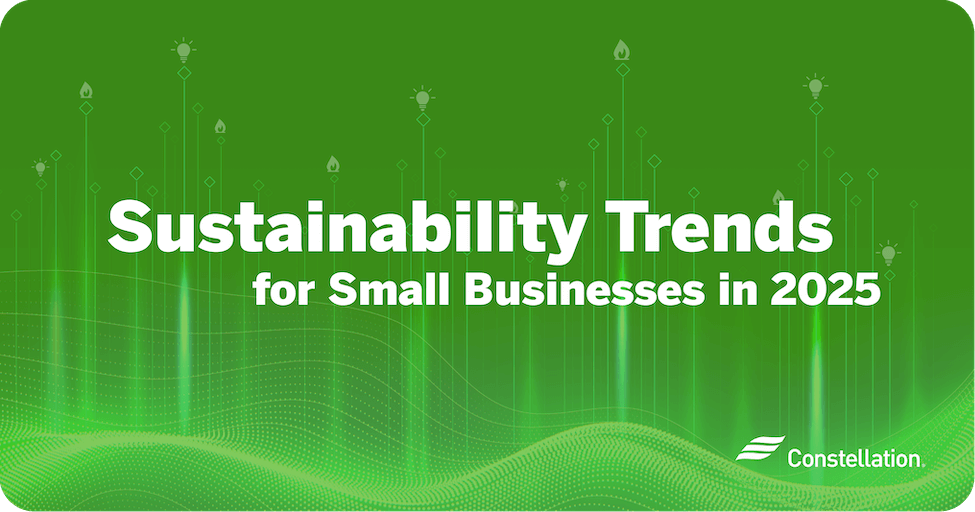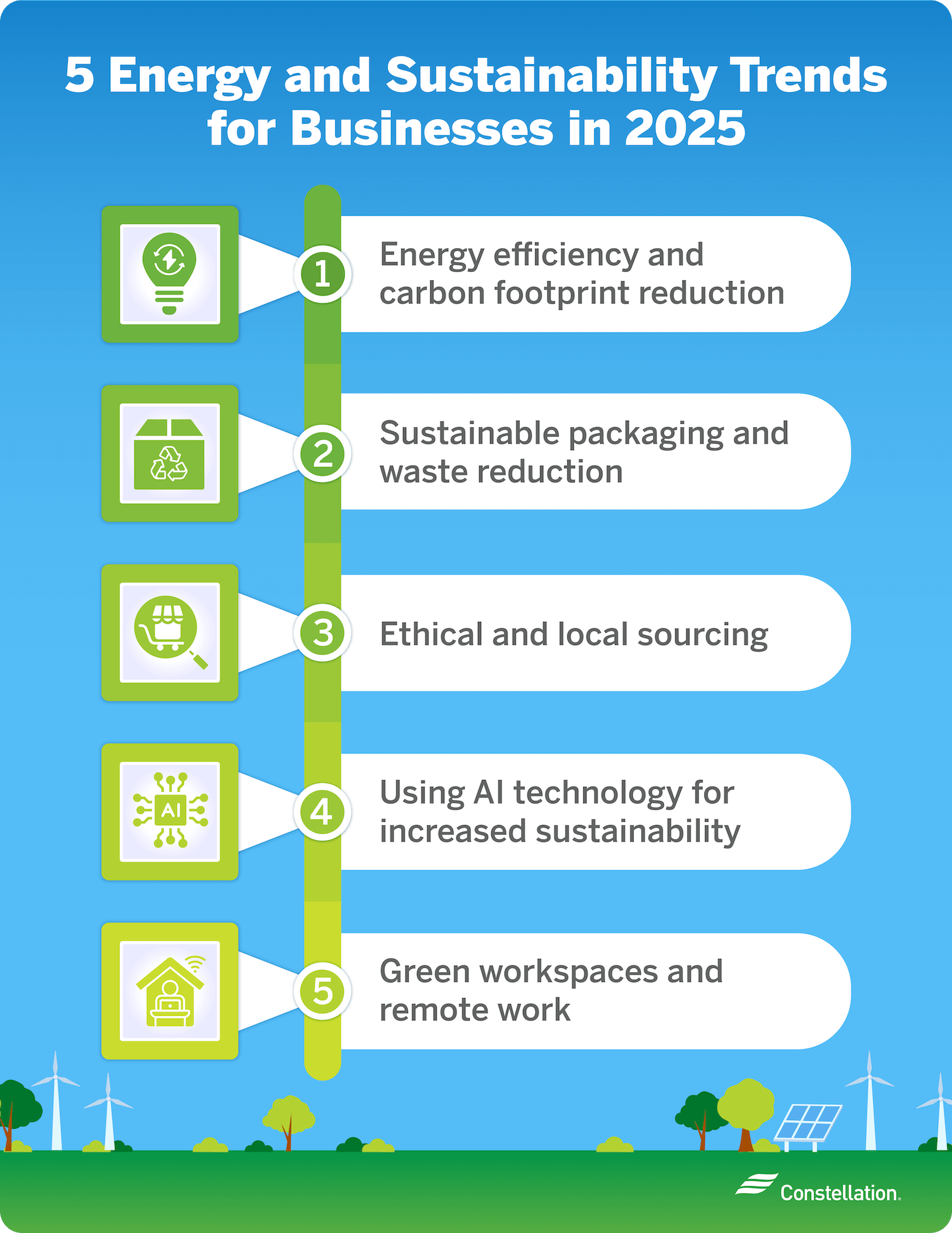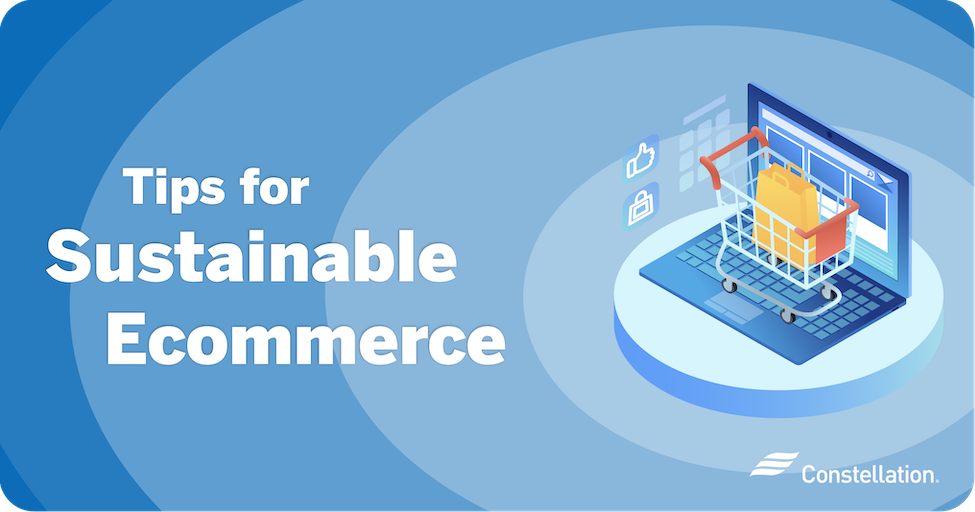
- Category:
Small Business Energy Savings -
Last updated:
March 27, 2025
Sustainability Trends for Small Businesses in 2025
Sustainability is one of the small business trends in 2025 that is reshaping how businesses will operate now and into the future. Sustainability technologies and energy options are now more affordable and are easier to implement, making them practical for small businesses. Here is a roundup of sustainability trends in business that you can put into practice now.
Jump to section:
- Energy efficiency and carbon footprint reduction
- Sustainable packaging and waste reduction
- Ethical and local sourcing
- Using AI technology for increased sustainability
- Green workspaces and remote work
5 energy and sustainability trends for businesses in 2025
Caring for the environment and being energy efficient is good for business, which is why business sustainability trends have been taking off. When you invest in achieving your business sustainability goals, you can cut costs, make it easier to comply with regulations and contribute to a healthier environment while helping your business earn the respect and loyalty of customers — especially the growing number of Gen Z consumers. Below are some practical 2025 sustainable small business trends worth considering.

1. Energy efficiency and carbon footprint reduction
Saving energy can trim your budget and lower your carbon footprint. Many ways of reducing your energy consumption are simple and inexpensive to implement. Improve your building’s energy efficiency by upgrading to energy-efficient appliances, using LED lights, improving insulation and using AI-powered smart energy management systems. Adding solar power is a more expensive option, but you have alternatives, such as switching to a renewable energy plan and buying carbon offsets. You will help the environment and boost your profitability.
2. Sustainable packaging & waste reduction
The circular economy is another of the sustainability trends in business that makes sense for many. This includes:
- Switching to production methods and packaging that is more sustainable.
- Initiating a composting program at your site.
- Participating in recycling programs.
- Involving consumers in your program.
3. Ethical and local sourcing
Respect for human communities and nature when procuring materials for your business is the heart of ethical sourcing. What this means in practice is taking time to look at suppliers to make sure they use fair labor practices, do no harm to animals and the environment and are transparent, ideally providing data about their own supply chain.
So-called Scope 3 emissions matter. Consider the carbon footprint of manufacturing, shipping, use and disposal when sourcing materials for your company. Local sourcing helps your immediate community and cuts down on shipping costs and emissions. Reporting your work on ethical sourcing is something consumers increasingly value.
4. Using AI technology for increased sustainability
When it comes to trends in small business, AI dominates the headlines. Use AI to increase efficiency across business operations. When you connect AI-powered systems with Internet of Things (IoT) sensors to optimize energy use and reduce waste, you can dramatically cut your energy consumption.
AI has applications in other areas, too. Small business trends that involve AI in manufacturing, inventory management, shipping optimization and more are making businesses more efficient, and that translates into sustainability. Consumers ultimately benefit from better products, better service and competitive pricing.
That said, the environmental impact of AI can be substantial. Keeping data centers lit and operating requires a significant amount of energy, in addition to large amounts of water to maintain cooling systems. To limit these environmental effects, it’s important to use AI responsibly in your business and develop strategies for reducing energy consumption when leveraging AI processes.
5. Green workspaces and remote work
Employees thrive in green workspaces and they are attractive to customers, too. We’ve already covered ways to cut energy use. You can add to a sustainable office environment by reducing paper that cuts down on clutter. Eliminate single use cups, plates and cutlery and remove plastic from the break room. Encourage employees to turn off machines — even unplug them — when not in use. Also promote the use of public transportation and biking to work. Or eliminate some of the commuting by letting employees work from home or work remotely more often.
Which sustainability trends matter most for your business?
Not all sustainability trends in business will work for your situation. Some are costly and time-consuming. Some apply to office environments and others to manufacturing. Your business may not even have much in the way of facilities, concentrating mostly on remote service at client sites. When evaluating small business trends, take some time to understand environmental sustainability, then pick and choose to adopt what works for you.
2025 sustainability trends to reduce your operating costs
Sustainability trends in business reduce your operating costs and boost profitability in a number of ways. Sustainable practices lower energy expenses. Reducing waste and clutter lowers procurement and waste disposal costs. Paying attention to your supply chain can lower your carbon footprint and trim outlays for business inputs and transportation. You may also qualify for tax credits and various grants, while avoiding fines and compliance fees. Lastly, you will attract consumers who prefer sustainable brands at better prices.
Meet customer and employee expectations with your 2025 sustainability efforts
Part of what drives business sustainability trends are customer and employee beliefs and values. Caring for the environment is no longer a nice-to-have business principle — for many, it is a requirement. Consumers and employees are highly eco-aware and value responsible and ethical businesses. They expect transparency and accountability, so it makes sense to communicate your sustainability strategy. Investing in sustainability is one of the trends in small business that is building trust and loyalty, internally and externally, while contributing to the bottom line.




